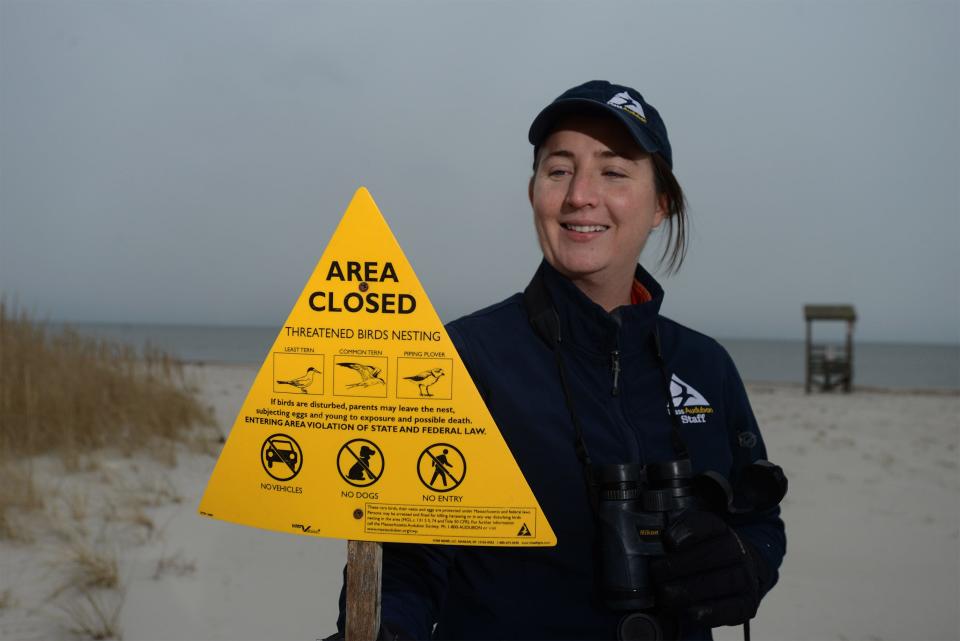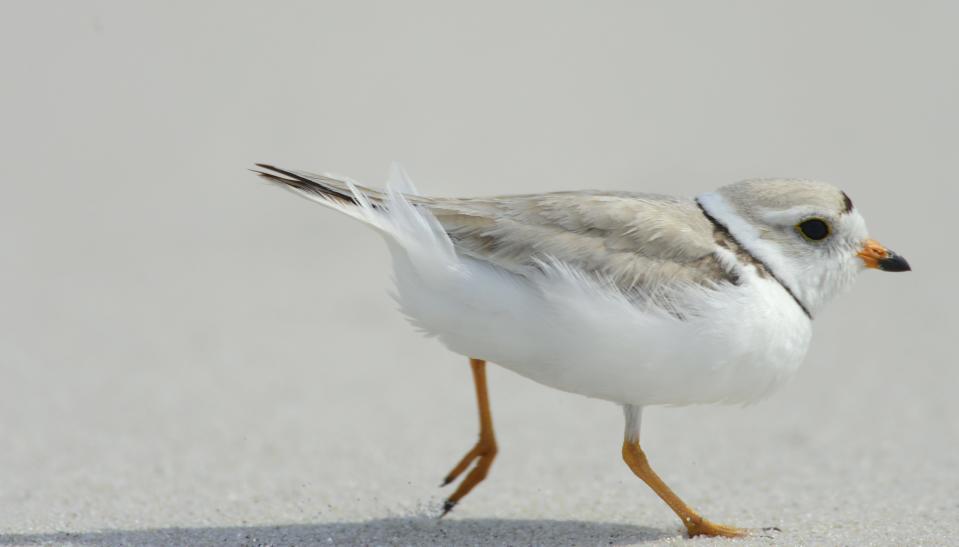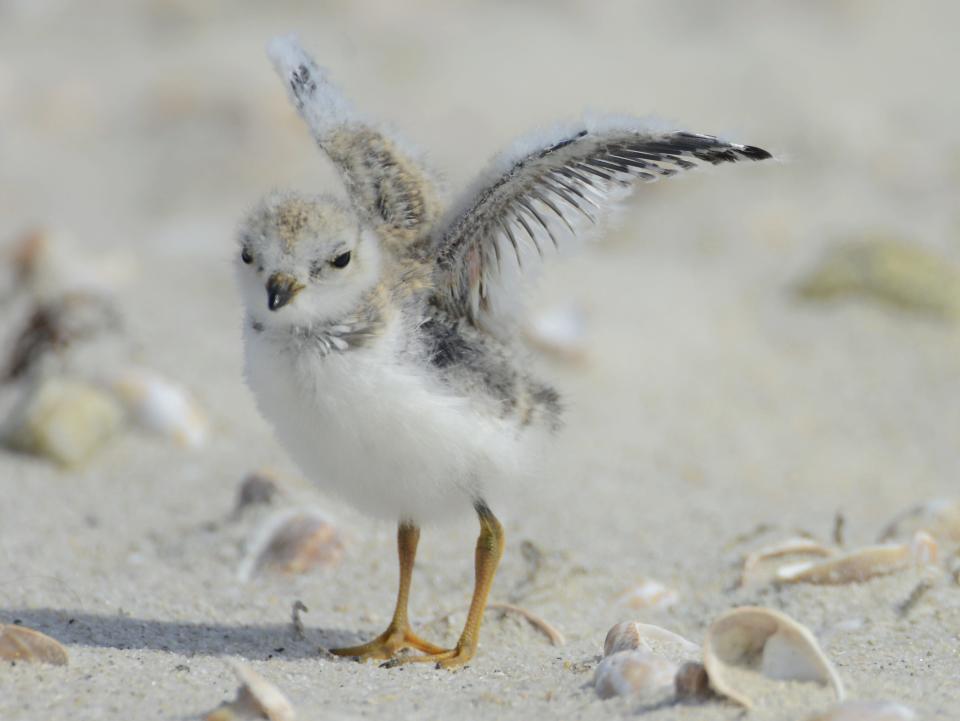'Back from the brink.' Long effort to save plovers paying off, Cape conservationists say
WEST BARNSTABLE — Out on Sandy Neck Beach, the seagrasses tremble stiffly in an icy January wind — nothing at all like their soft, pliable movement in summer breezes. At this time of year, the sands are gelid and desolate, attracting only the most intrepid visitors.
Caught in the solitude of winter, the beach seems to be holding its breath, silent except for the waves and the whipping air. Waiting. Soon enough, the sands and the wind will soften, and the beach will begin to breathe again with other sounds, including the peeping of piping plovers.
At Sandy Neck, the town of Barnstable management team is standing by to ensure the plovers are protected when they start arriving, usually around the first of April. Sandy Neck is one of the places on Cape Cod where the tiny, threatened shorebird shows signs of resurgence.
"We have quite a substantial population on Sandy Neck. In the last three to four years, we've been seeing jumps in the number of breeding pairs," said Nina Coleman, Barnstable Director of Natural Resources and Sandy Neck Beach Park Manager.
Last year, Coleman said, "We had 57 breeding pairs, and that was a record. The year before, there were 50 pairs, and that was a record as well."

Recent findings by Mass Audubon show more plovers
What Coleman and her team are observing is borne out in recent findings by the Massachusetts Audubon Society that more piping plovers nested last season on beaches on Cape Cod and elsewhere in Massachusetts than have been observed in nearly 40 years.
Lyra Brennan, the director of Mass Audubon Coastal Waterbird Program, said it is a testament to concerted conservation efforts by the state, town governments, beach managers, landowners and conservation organizations, including Audubon and the National Park Service.
The efforts, she said, demonstrate how local and agency partnerships, direct protection, targeted conservation and careful research "can bring threatened species back from the brink of disappearance if we are willing to make the long-term investments necessary for success."
The work started in 1986 when piping plovers were listed as threatened under the federal and the Massachusetts Endangered Species Acts.
"The pairs in the state had dropped down to 135," said Brennan, who is based at the Mass Audubon Long Pasture Wildlife Sanctuary in Barnstable.
Now, she noted, "we have over 1,100 pairs in the state."

Cape Cod plays pivotal role
According to preliminary data from the Massachusetts Division of Fisheries and Wildlife, compiled through the agency's Natural Heritage & Endangered Species Program, an estimated 1,145 plover pairs nested in Massachusetts during the 2023 season — an increase of more than 500% since the program began.
And Cape Cod has played a pivotal role.
The most nesting pairs have been observed at Monomoy National Wildlife Refuge and on South Beach, both in Chatham, Brennan said, "and then, of course, there are many on the National Seashore and at Sandy Neck."
Mass Audubon reports plovers are also coming back to nest on many other beaches across the Cape and all along the Massachusetts coast from Gloucester to Scituate, where they haven't been for many years. Seagull Beach in West Yarmouth, for example, is attracting more plover pairs and least terns, a shorebird of special concern.
"There are also a number of beaches in Falmouth that have become active that have not been active in recent years," she said, naming Menauhant and Wood Neck beaches among them.
Millinery trade, development, more beach use and climate change
Historically, plovers and other birds fell victim to the millinery trade when feathers were in demand for decorating hats in the 1800s, according to Brennan. But their steep decline into the 1980s resulted from heavy, unregulated beach development and beach use — in particular, unleashed dogs and off-road vehicles.
With development also came more predators, drawn by food sources available around housing and scraps left on the beaches. Predators continue to be a threat, especially crows and coyotes.
"The other more existential threat is climate change," Brennan said, explaining that increasingly intense storm events and rising sea levels can cause flooding that washes nests out.
Camouflage: a blessing and a curse
Plovers raise their young in the soft sand at the back edge of beaches, between dunes and the high tide line. Their nests, called scrapes, are simple affairs, just depressions in the sand to deposit tiny, speckled brown eggs that blend in with beach rocks. Usually, plovers lay four eggs shortly after their arrival, between mid-April and mid-May. Hatchlings emerge in May and June. Around July, the young take their first flight, and in August, the plovers begin to leave.
"They nest right where you want to put your beach chair," Brennan said.
The birds' plumage and diminutive size help them to blend in, making them difficult to see when they're not scurrying back and forth in the surf while feeding. Blending in, Brennan said, "is really their only defense," but without protective measures, it's also a disadvantage because it's easy for people and pets to step on nests and disturb the adults.
When overly disturbed, sensitive adult plovers may abandon a nest and begin again elsewhere. They may re-nest up to five times if necessary, which means extending how much time they spend in their summer breeding grounds.
In January: 'A nice compromise.' Barnstable won't shorten off-season beach walks for dogs
Conservation has come a long way since the 80s
Brennan said communities "have come a long way in respecting plovers and respecting nests" since 1986, regulating where off-road vehicles can operate, closing down sections of beaches when necessary, requiring dogs to be on leashes and putting up fencing and signs when there are nesting pairs present.
In Barnstable, Coleman said fencing is a key conservation measure.
"We usually see the plovers return in late March, and then, generally, protections start April 1, so that's when our fencing needs to be in place," she said. "We also have a lot of dog control practices in place, and Sandy Neck is heavily patrolled by uniformed officers, so there's quite a bit of education and enforcement."
Coleman's team also sometimes erects wire enclosures around nests, though they choose to do so sparingly as "some predators have learned to key in on them."

A challenging balancing act
It hasn't all been smooth sailing. Brennan acknowledged the plovers' need for beaches to nest is sometimes at odds with human uses of beaches for recreation in the warmer months, from swimming to off-road driving and camping.
"There's no point dancing around. It can be really difficult to balance all of these things. Some people have been doing these things for years, and then the plovers start showing back up," she said. "So, there's a lot of conversation going on about balance and about wildlife being able to live alongside people."
That said, these days there is conversation and cooperation among the interests. Brennan noted that the Massachusetts Beach Buggy Association, in particular, "has been very productive in the conversation around plovers." The organization could not be reached for further comment on their role.
"It takes a village," she said. "It's the work over many decades of protection and education so people understand why areas of the beach are sometimes closed off."
Researchers are collecting "an incredible amount of data," she added, so there's identification of what threats are present at specific beaches and "we can try to adapt and do better as the years go by at that site."
Achieving co-existence with plovers
The aim is "just trying to allow wildlife to do what they need to do without being interrupted by humans. We really want that first nest attempt (April to May) to hatch those chicks to be successful," Brennan said.
The more that's done to minimize disturbances in the early season, the less re-nesting occurs and the shorter the hatching and fledging period is.
Places like Seagull Beach in West Yarmouth, where nesting pairs are showing up again despite it being "a very crowded beach during the warm months," proves that people and plovers can successfully coexist, Brennan said.
In the big picture, "birds are the canary in the coal mine," Brennan said, so their presence indicates a healthy, thriving system. "It's all interconnected."
Remaining vigilant
Although the plover numbers are increasing, conservation scientists remain on watch. Plovers, as well as other shorebirds such as terns and American oystercatchers, continue to be vulnerable to human disturbances and climate change, said Jamie Infanti, program manager for the Audubon Coastal Waterbird Program.
“To allow all shorebirds and seabirds to return to healthy population levels in Massachusetts," she said, "we'll need to keep pushing for sustainable protection and management of the essential coastal habitats where these iconic species raise their families."
As Brennan explains, a full recovery of once nearly decimated species like the plovers is up to state and federal wildlife agencies, and they have a number of criteria that need to be met.
"An example of this criteria: the federal Fish and Wildlife Service requires a full recovery of pairs across the whole Atlantic coast."
"Piping plovers are doing well now in New England," she said, "but we are a part of the entire Atlantic coast population, and other recovery units — geographical plover populations — are not matching the success of the New England recovery unit."
Heather McCarron writes about climate change, environment, energy, science and the natural world. Reach her at hmccarron@capecodonline.com.
Thanks to our subscribers, who help make this coverage possible. If you are not a subscriber, please consider supporting quality local journalism with a Cape Cod Times subscription. Here are our subscription plans.
This article originally appeared on Cape Cod Times: Risks to piping plovers on Cape, statewide remain, Mass Audubon says

